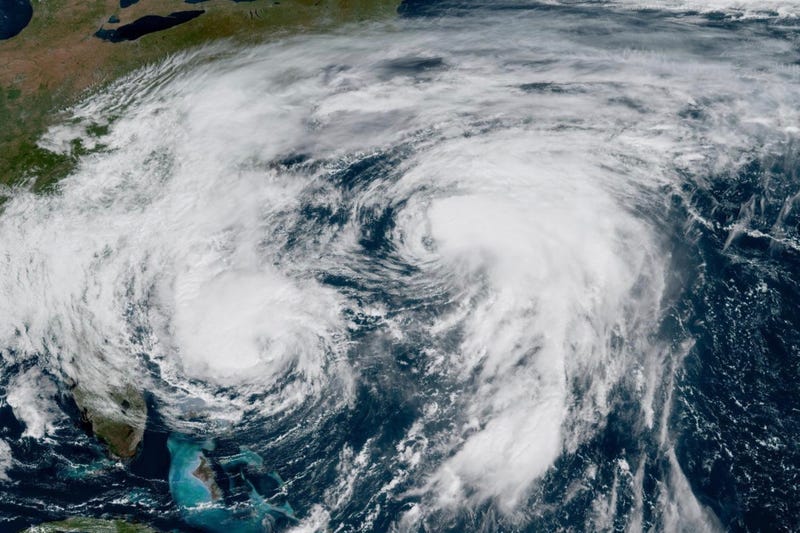
SAN JUAN, Puerto Rico (AP) — Hurricane Imelda barreled toward Bermuda on Wednesday as forecasters warned that it would swipe past the tiny British territory as a Category 2 storm.
Heavy winds and rain were expected to start hitting the island and continue through Thursday, with Imelda forecast to pass near or over Bermuda on Wednesday night.
A hurricane warning was in effect for Bermuda, a wealthy overseas territory with strong structures that have withstood powerful storms in previous years.
Imelda was located about 270 miles (435 kilometers) west-southwest of Bermuda. It had maximum sustained winds of 100 mph (155 kph) and was moving east-northeast at 20 mph (31 kph), according to the U.S. National Hurricane Center in Miami.
“This is a dangerous storm system that could bring destructive winds, heavy rainfall and significant coastal impacts,” said Michael Weeks, Bermuda’s national security minister.
Bermuda closed its public schools, government offices and international airport on Wednesday as it deployed 100 soldiers to secure infrastructure, clear roads and help at emergency shelters ahead of the storm.
Imelda is expected to drop up to four inches (10 centimeters) of rain across Bermuda and produce a dangerous storm surge that forecasters say could unleash flooding. More than 900 customers were already without power by Wednesday morning, but crews had restored electricity to a majority of them ahead of the storm, officials said.
Deadly storm
Earlier in the week, Imelda pummeled the northern Caribbean, unleashing widespread flooding in eastern Cuba, where two people died.
In the province of Guantánamo, more than 18,000 people were evacuated, while in Santiago de Cuba, flooding and landslides cut off access to 17 communities where more than 24,000 people live, according to state reports.
On Wednesday, more than 3,500 people remained evacuated in Guantánamo while crews began to repair damaged roads and bridges in the area.
Meanwhile, authorities in Haiti said that one person is missing and two were injured following heavy flooding in the country's southwest and northwest regions.
Hurricane Humberto dissipated on Wednesday after passing west of Bermuda on Tuesday.
Beaches hit by dangerous swells
Imelda and Humberto's remnants were generating dangerous surf and deadly rip currents affecting beaches along the north Caribbean, Bahamas, Bermuda and much of the U.S. East Coast.
At least five unoccupied houses along North Carolina’s Outer Banks collapsed into the ocean on Tuesday, according to the U.S. National Park Service, marking the latest private beachfront structures to fall into the surf there in recent years.
This Atlantic hurricane season marks the first time in 10 years that a hurricane hasn't made landfall in the U.S. through the end of September, according to AccuWeather, a private U.S. weather forecasting company.
“This hurricane season so far is quite unique, with several close calls for the United States,” said Alex DaSilva, AccuWeather’s lead hurricane expert.
Only Tropical Storm Chantal made landfall in the U.S. earlier this year.
He noted that Humberto pulled Imelda away from the U.S. East Coast in what’s known as the Fujiwhara Effect, a rare phenomenon in the Atlantic in which two storms are so close together that they start rotating counterclockwise around each other.
Humberto and Imelda were a mere 467 miles (751 kilometers) apart earlier this week, the closest distance recorded between two Atlantic hurricanes since 1853, according to Michael Lowry, a hurricane specialist and storm surge expert.
While the Atlantic hurricane season is winding down, DaSilva urged people to remain alert.
“We expect atmospheric conditions that could support tropical storms and hurricanes well into late October and November this year,” he said.
Imelda, which reached hurricane strength on Tuesday, is the Atlantic season’s fourth hurricane this year.
The U.S. National Oceanic and Atmospheric Administration had predicted an above-normal season with 13 to 18 named storms. Of those, five to nine were forecast to become hurricanes, including two to five major hurricanes, which pack winds of 111 mph (178 kph) or greater.
The Atlantic hurricane season runs from June 1 to Nov. 30.
___
Associated Press videographer Milexsy Durán in Havana and reporter Gary Robertson in Raleigh, North Carolina contributed to this report.